#Loco Hauled Passenger Train
Explore tagged Tumblr posts
Video
Ark Royal Waiting For The Off (Michael McNicholas) by Neil Harvey 156 Via Flickr: 50035 "Ark Royal" waits to leave Penzance with 1A49 10:35 to Paddington. 9/7/89. The loco had just under a year to go in active BR service, being withdrawn on the 5th August 1990 and entering preservation in August 1991.
#Railway#50035#Ark Royal#Penzance#Cornwall#Loco Hauled Passenger Train#1A49#Class 50#Network South East#English Electric Type 4#Hoover#Michael McNicholas#diesel locomotive#trainspam
0 notes
Video
Apedale steam 1 por Nigel Por Flickr: The Apedale narrow gauge near Chesterton , Staffordshire held their winter warm up steam gala on 28th December 2024. Featuring 4 locos in steam and for the first time on the line Bagnall Wotto was hauling passenger trains.
11 notes
·
View notes
Note
I've been meaning to ask, all of VR's locomotives seem to be named SrXX, SvXX, DrXX, ...
What does the prefix (Sr, Sv, Dr, ...) mean? Presumably its something along the lines of "Diesel Locomotive" in Finnish or something, but I'd love to know!
You got it very close! I was going to make a detailed entry about the different systems that have been in use (as there have been three different ones for locomotives over the years, plus a separate one for multiple units), but entirely forgot. So I'll just do it here.
In the current system (taken into use in 1976):
The first (capitalised) letter is the (primary) power source D for diesel S for sähkö (electric)
The second (lowercase) letter signifies axle weight: k (kevyt) light loco of less than 11 metric tons per axle (there are currently no k locos) v (väliraskas) midweight loco of 11-16 metric tons r (raskas) is heavy locomotive of more than 16 metric tons
Multiple units follow a similar system, except the lowercase letter is always m for moottorivaunu, motorized carriage.
The numbers should theoretically just be a running numbering, but this only holds true for electric locos. The diesel numbering is a mess with gaps and numbers not being in consecutive order (the numbering started with Dr12, there never was a Dr17, and Dr20, Dr21 and Dr35 all predate Dr19).
Then to make things more complex, in 1942-75 a different system was in use where the first letter signified what types of trains the locomotive was primarily designed to haul.
H for henkilöjuna (passenger train) T for tavarajuna (freight train) S for sekajuna (mixed train, though this came to mean mixed use towards the end) P for paikallisjuna (local/commuter train) V for vaihtoveturi (shunter)
In practice pretty much all locos except for the V's were mixed use ones already during the steam era: for example the Pr2 local traffic locos were mostly used to haul long-distance express trains and occasionally did freight trains too. For diesels, the flagship locos were classed as Hr's (even when they could not be used to haul passenger trains, as was initially the case with the Hr13), but apart from shunters all other locos were simply classified as S's. It's also maybe amusing that the first electric locos were delivered under the old system as Sr1 (mixed-use heavy loco 1), and kept the same designation under the new system, thanks to Finnish having an invented word for electricity that also begins with an S.
At the same time with the changeover to the current system they also changed the breakpoint between v and r, resulting in Sr12 (mixed use heavy loco) becoming Dv12 (diesel midweight loco). I sometimes wonder if there will be another overhaul once the last Dv12 is retired, as apart from those locos all in-use Finnish locos are in the r weight. Should we change the "borders" between the different weights again, or maybe just change the small letter to v for veturi (locomotive) to differentiate from the m for multiple units?
Finally, up to 1942 loco classes were given a single capital letter and a running number based on the wheelbase (which I think is/was the system also used in Sweden). And for whatever reason letters A through F were recycled for new wheelbases at different times, but we never went through the full alphabet; R was the last letter to be taken to use.
30 notes
·
View notes
Text
Gordon the Big Engine [NWR AU]

Yeah, I'm not quite ready for Henry yet.
History
Gordon was built in 1922 as the prototype for the Great Northern Railway's A1 Pacifics. The tests proved less than satisfactory for the GNR's needs, and thus he was sold to the North Western Railway to work the Wild Nor' Wester express. He was repainted into North Western Railway blue upon his arrival and given the number 4. He was stabled at Vicarstown sheds, where he'd often butt heads with the other engines due to his arrogance. During Henry's periods of illness, Gordon would take the Flying Kipper service, gaining much of his grumpy attitude from sleep deprivation.
During the Second World War, Gordon worked fast freights, troop trains and evacuee trains, his speed and power making him a valuable asset. This all came to a very abrupt stop in 1942 when he fractured his central cylinder outside of Wellsworth. In no position to lose one of his main fleet, Sir Topham Hatt sent him to Derby Works where he was fitted with a pair of larger Stanier-designed cylinders to replace his trio of Gresley ones. To fit these, however, they had to raise his running board at the front, forever altering his appearance. Seemingly unfazed by this, Gordon returned to service in 1943 and continued to work just as hard if not harder than before, being reallocated to Tidmouth in 1945.
In 1949, British Railways offered to rebuild Gordon above the frames to the specifications of an A3. Sir Topham Hatt accepted and Gordon made the trek to Doncaster light engine and under his own steam. When he returned to traffic a few months later, his driver remarked that the increase in his engine's power output was so great that he felt he was an entirely different engine. This was demonstrated in early 1950, when Gordon slipped violently outside of Tidmouth Station, bending his eccentric rods and melting the bearings on his return cranks. He was sent to Crovan's Gate Works, where the engineers spent a long while tinkering. When he was returned to traffic in 1951, he had finally been fixed for good. He went on to run the express as usual, joined by Bronzino and Velocity in 1963, Blenheim in 1965 and Larkspur in 1980.
In 2011, the loco-hauled leg of the Wild Nor' Wester express train was axed for good with Gordon and Edith double-heading the train. Since then, Gordon has been assigned to regular fast passenger trains and railtours.
Personality
Gordon's colourful personality needs no introduction, being arrogant, grumpy, snooty, aloof and boastful. Though he has calmed down in recent years, he's still very much the same Gordon he was in 1922. He has a close relationship with Henry and James, the three often being inseparable at the sheds. He also has quite a strong bond with Velocity, Bronzino and Larkspur, all 3 having been ECML staples at some point. All in all, Gordon may be grumpy, irritable and obnoxious at times, but is a trustworthy and formidable ally to have.
Thank you very much for reading, I hope to see you in the next one.
Cheerio!
11 notes
·
View notes
Text
Big Harry Is Ailing by Jack Evans
The Argus, Saturday July 21, 1951
I took the text because the article shape is so awkward.
*cues in Sad Henry music*
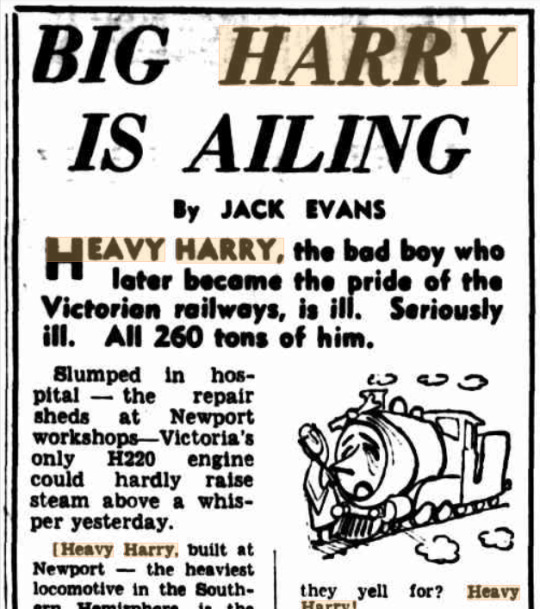
BIG HARRY IS AILING By JACK EVANS
HEAVY HARRY, the bad boy who later become the pride of the Victorian railways, is ill. Seriously ill. All 260 tons of him. Slumped in hospital - the repair sheds at Newport workshops, Victoria's only H220 engine could hardly raise steam above a whisper yesterday.
Heavy Harry, built at Newport - the heaviest locomotive in the Southern Hemisphere, is the only one of its type in Australia. His massive size and varied adventures made him pride of the rail engine fleet during World War II.
"Overwork, that's what caused it," he gasped yesterday. "I've got something wrong with my boiler." He said sadly: "You know, you're the first visitor I've had since I came to hospital. No one cares."
Work Of Two
"Why, Mr. Hyland, Transport Minister, was proud to drive me when I was launched in '41. Kiddies flocked to see me when I went on exhibition. "But as soon as you get sick you're forgotten. "In 10 years I've travelled more than half a million miles for the Railways. And I've pulled millions of tons of freight between Albury and Melbourne, doing the work of two engines."
He added, indignantly: "These new R Class engines are getting all the limelight now. Running around painted red and black, with all the glamor of Essendon footballers "
"And letting girls ride on their footplates. I was brought up better than that, and I've never worn anything but decent black all my life!
"Going to haul passenger trams from Bendigo, are they? Bah! When the Railways got into a jam with the Spirit, who did none Help they yell for? Heavy Harry! "They tell me those R Class engines stole the show in the Engineering section at the Festival of Britain. They sound more like mannequins instead of machines. "And boasting about their mechanical stokers! Let me tell you, I had the first mechanical stoker in the whole of Victoria. And the best! "I heard my boss, Commissioner Wishart, say that 70 of them -were coming from England. And half-a-dozen streamlined diesels from U.S.A.
"What about accommodation problems? He wants to remember there is a shortage of engine round-houses here." Harry brightened up towards the end of the interview.
"I'll be back on the track soon," he prophesied. "All 92ft. 6in. of me, and fighting fit. "Those glamor jobs had better hunt a quiet siding. If I meet them on a foggy night I'll show them that Old Harry hasn't lost his punch."
A couple of notes:
Jack Evans seems to be using the character of Heavy Harry to critique the VR, which is entirely valid since the railways were about to get absolutely slaughtered by our own native version of Beeching and didn't recover for another 60 years.
The North British Works-built Hudson R-class "glamor jobs" they talk about weren't bad engines, just wholly unsuited to the jobs VR assigned to them, which were goods trains rather than express passenger trains like they were built for.
(And they're Scottish, Harry! They were built at Glasgow! You know this!)
They did bear a scarlet and black color scheme... possibly to connote in a new era their passenger engine status (red, used on express passenger locos in the pre-Clapp era on A2s and other passenger locomotives), wedded to standard VR black.
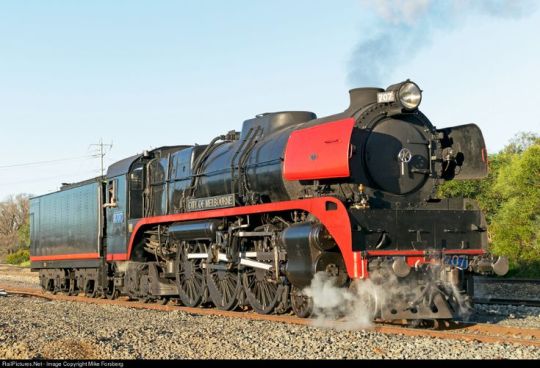
(Hudson R 707 "City Of Melbourne")
The Lancastrian built J-Classes, the last steam engines built for VR, also bore this scarlet and black scheme.
Essendon Football Club were the glamor team of the Victorian Football League (Australian Rules football) at the time, having appeared in almost every single Grand Final since 1941, which is kinda funny that he gives the Rs a serve for their color scheme... as I have Harry as an Essendon supporter in my OC headcanon, lol. (strong IRL historical associations between Essendon and Heavy Harry).

(Outside of Essendon Railway Station, bearing a photo of ‘Harry on the Express to Albury at Essendon, 1949’… old timers living here would recall Harry shaking the earth as he passed).
Him threatening to bash the "glamor jobs" though... is dead on like my OC Harry! Cranky, prone to melancholia, painfully aware of how alone he is. That is Heavy Harry.
Also:
"Overwork, that's what caused it," he gasped yesterday. "I've got something wrong with my boiler." He said sadly: "You know, you're the first visitor I've had since I came to hospital. No one cares."
"I SUFFER DREADFULLY AND NO ONE CARES"
Both rebellious, troublesome engines with issues.
Canonically both melancholy and lonely engines with wide angry streaks.
Both are fairly unique engines. Harry is the sole Pocono with a third cylinder that exists, sole member of his class. Henry was a failed hybrid turned Black Five, the sheer fact of this makes him fairly unique.
Both seem fond of flowers (see the illustration in my earlier Heavy Harry post).
Both he and Henry were originally meant to be express passenger locomotives but turned to the purpose of night/early-morning fast goods.
Both are fond of their "special coal" (Harry worked best on the Oz version of Welsh coal, Maitland coal).
"Harry" is a variant of the name Henry.
This particular article was put out less than two weeks after the publication of the book "Henry the Green Engine", on the 10th of July 1951.
Neither seem interested in ladies, canonically.
The little drawing they put in it is basically Henry…
Just sayin'! If Twin Flames existed... It’d be these two. Har’ is basically an Oz version of Henry…
So fucking weird when you find such off-kilter content about something you are interested in. Also, H220 and its the 22nd of the month so...
#Victorian Railways H-class Pocono H220 “Heavy Harry”#The Argus newspaper#The Railway Series Down Under#trains in the wild#thomasallgrownup#Victorian Railways#real locomotives#VR H-Class Pocono H220 “Heavy Harry”
30 notes
·
View notes
Text
The more I think about Electra specifically being a locomotive vs power car or EMU the more I dial in on a lot of my more contrarian physical preferences. It’s a very important distinction socially, especially as separate locomotives and cars not in permanent trainsets become gradually rarer (especially in Europe). I went over it in my train social divisions post, but power cars almost always keep to their trainset, EMUs are self-powered and tend to be separate from the coach/engine divide unless they really suck at self-propulsion and end up unpowered coaches (like the Metroliners). Locomotives are fairly distinct in that they’re more flexible and can bounce around between duties, and virtually all freight is loco-hauled so there’s a major chance of crossing over later in life even if you are originally on passenger duty.
but basically by being a separate locomotive Electra would probably be physically pretty small (both height and length), we’re talking 50-65 feet long vs 80ish foot coaches and MUs and 70ish foot Greaseball, and depending on model, several inches to a foot shorter than Greaseball vertically (as engines). The early carbody engines Greaseball is based on were… infamously NOT very strong as individual units, especially compared to contemporary electric engines, it actually weirdly makes sense for Electra to be much beefier than him. Strength is just… not very relevant in a race pulling only one car and I think Electra just doesn’t care and Greaseball just leans back on old propaganda/perceptions of diesel power. tbh I have zero interest in modernizing Greaseball into something newer, larger, and more fitting to Pumping Iron because I just think being an EMD E9 is compelling and nearly timeless since they were used on corporate trains for so long (including UP’s until a few years ago). I just think it’s fascinating and fitting that he’d try and gaslight people into “diesel stronk because it go brrrr” messaging despite being the epitome of underpowered early diesel locos (this was a problem for several decades due to tech limits).
#i’ll do my post about emd and early carbodies but trust me it’s something I actually love about greaseball#because other than the funny strength contrast there is soooo much fitting stuff about the cultural dominance of them#the emd export model rabbit hole goes deep. early EMDs kind of sucked but were so repairable/rebuildable they’ve lasted forever#he is weirdly a scrappy survivalist and “survival of the good enough vs fittest” incarnate#they were also the engines that killed steam but tbh steam power only becomes less sympathetic the more i learn
3 notes
·
View notes
Video
youtube
Flixtrain Loco is awesome! Train Sim World 5 Deluxe Edition
LONDON Be swept off your feet with the commuter mayhem of the WEST COAST MAIN LINE. From the detailed cab of the Northwestern Class 350, operate semi-fast and commuter services between Euston and Milton Keynes.
DELUXE EDITION: Lean into even more action on the WCML with the sleek and famous Avanti West Coast Class 390 Pendolino, tilting around bends in speedy fashion!
FRANKFURT Variety abounds on the twisting KINZIGTALBAHN. Bank around the scenic Kinzig Valley aboard the tilting DB BR 411 ICE-T, shuttle along the line in the regional BR 114 + Dostos, and haul freight with the mighty DB Vectron. It’s all systems go between Frankfurt and Fulda.
DELUXE EDITION: Experience additional passenger flavour on the Kinzigtalbahn with FlixTrain traction! Vectron and Talbot coaches wear bright green for iconic cross-country rail travel.
LOS ANGELES The Sun-soaked tracks of the SAN BERNARDINO LINE play host to Metrolink movements. With both the powerful F125 and sleek MP36, hustle between highways and dash from town to town on the daily suburban commute. Connect the sprawling Greater LA metropolis and run to the foothills of the Cajon peaks.
DELUXE EDITION: Hop to the hills of BNSF territory with CAJON PASS. Master mountain pass railroading over the peak to Barstow and operate local freight on the San Bernardino Line.
CONDUCTOR MODE A new way to play! CONDUCTOR MODE puts you into the role of a guard/conductor on any service – check tickets, operate the doors and ensure passenger safety. Take a break between driving and master a different discipline.
THE RAILS ARE YOURS With customisation tools such as CREATORS CLUB, PHOTO MODE and more, embark on your own journey, in your own way.
LIVE MAP: Get a real-time, birds-eye view of any route. Become familiar with station locations and find out when the next train is heading your way with detailed information.
ROUTE HOPPING: fast-travel across routes to catch the action at any station or hop between geography-shared routes on-foot to access your collection (other route add-ons required).
Train Sim World 5 on Steam: https://store.steampowered.com/app/2967990/Train_Sim_World_5/
#trainsimworld5 #jimmydali #tsw5 #dovetailgames #simulation #trainsimworld #trainsim
0 notes
Text
The Black Wolf
The Black Wolf was the flagship train from London to Gunnigrind. Launched in 1931 with the allocation of Royal Scot class locomotives, the about 650 mile journey taking around 16 hours, departing from their termini at 6:00 PM, and arriving at 10:00 AM the next morning.
The Black Wolf was a beast of a train, usually consisting of fourteen coaches (up until the BR days, this often included one of the LMS ex-Pullman dining cars, one rake usually had 216, the other having 219). The usual makeup had a brake coach, the dinner, two first class sleepers, two third class sleepers, three composite corridor coaches, and a third brake (later composite brake), then another first and third sleeper, a composite coach, and finally another third (later composite) brake. These final four coaches were to take up the Ben Fisag Branch.
Starting in 1933, Princess Royal class pacifics occasionally headed the train, and the Turbomotive was a common sight. In 1935 when Gunnigrind had 6204 allocated to its shed, and 6202 and 6204 largely took over The Black Wolf from the Royal Scots, although as the shed lacked a spare Pacific, they could not tighten the timetable in case of loco failures.
This changes in 1937 with the arrival of Coronation Class 6225, and so the schedule was tightened by a whole hour!
The second world war put a pause on named trains, however a similar train ran, carrying troops and people fleeing the London blitz.
In December 1947, Coronation class 6526 arrived in the island, and so the train became an almost exclusively Duchess hauled affair, although when BR 10001 arrived in July 1948, her and her LMS twin were trialled on the service, and were a regular sight doubleheading until 1949.
Also in 1949, 6202, now 46202, while climbing the bank out of Gunnigrind with the southbound Black Wolf, experienced a catastriphic turbine failure, leading to her rebuild.
On October 8, 1952, 46202, with the northbound Black Wolf, collided with an out of control stone train coming from the Ben Fisag Branch, resulting in the near destruction of both the engine hauling the goods train, 42724, and 46202, which were both written off, as well as the death of seven on the Black Wolf: both the driver and fireman, a guard, two cooks and two passengers in the dining car.
In 1954 71000 was constructed and allocated to Gunnigrind, and at first was incapable of hauling The Black Wolf satisfactorily due to design and construction flaws, which were able to be rectified at the small works in Gunnigrind that had been constructed by the LMS to repair experimental engines that were being tested on Seidrey.
In the late 1950s, Class 40s began to be allocated to The Black Wolf, and started to displace the steam locomotives from the service. However, the Class 40s had to doublehead the train to keep to time and to not overheat their engines while climbing the numerous gradients.
Because of displacement by diesel and the looming ban on near all LMS express steam traction south of Crewe due to electrification, the final steam hauled Black Wolf departed London Euston on the evening of 31 August 1964.
In 1961 the LMS sleeping cars were finally replaced by BR Mark 1s, and the train mostly stayed that way, due to utilizing composite coaches and there being no direct Mark 2 replacement.
Starting in 1966 The Black Wolf has an engine change at Crewe to an electric locomotive.
Also in 1966 the final four carriages of the consist were dropped, as the Ben Fisag Branch closed. Later the same year, Motorail service was introduced.
The Class 40s didn't last long on The Black Wolf, as they were found to be somewhat underpowered for the service. They were replaced by Class 50s in 1967, which were much more satisfactory.
In 1974, the engine change to electric traction was moved to Glasgow. Although most Class 50s has been moved to the Western Region, three had stayed behind to haul the Black Wolf
In 1977, the full brake and all the chair coaches were dropped, except for the brake composite, which was finally replaced by a mark 2 brake second open to be used solely as a lounge, leaving the train to consist merely of six coaches, not counting the Motorail flats. In 1979 the mark 1 sleepers were replaced by mark 3s.
The Black Wolf continued on in this form until its discontinuation in 1989, bringing to an end the saga of the longest distance individual train in Britain, The Black Wolf.
On June 4th, 1996, The Black Wolf name was revived, as a six to eight car segment of the Caledonian Sleeper to Gunnigrind, hauled by Class 47s until 2001, then Class 67s until 2016, when they started using Class 73/9s, which they use through the present day.
1 note
·
View note
Text
New South Wales C38 class locomotive, the "Pacifics"
Built between 1943 and 1949, the 30 locomotives in the class were made to haul express passenger services throughout New South Wales. theses locomotives where the last to be made in new south wales for passenger services. the builders of theses loco’s where Clyde Engineering with 5, Eveleigh Railway Workshops with 13 and Cardiff Locomotive Workshops with 12 loco’s made each. the 5 built by Clyde Engineering where streamlined. only 4 of the 30 class locomotives survived into preservation, 3801, 3813, 3820 and 3830. some info on the loco’s: whyte = 4-6-2, standard gauge, a wheelbase of 19.99 m (65ft 6in), a length of 23.29 m long (76ft 4in). with a total weight 201 long tons. theses locomotives where gray during the war

3801 the first loco made of the class, and one of the most well known locomotive in Australia with 3801 having visited all mainland states and territory's. 3801 had 3 overhaul’s from 1947 to 1963. The most famous run being a non-stop run from Sydney to Newcastle on 28 June 1964 only taking 2 hours 1 minute 51 seconds to do so this remained the fastest journey from Sydney to Newcastle until a XPT broke the record in 1988. 3801 was taken to the State Dockyard in Newcastle for restoration in November of 1983, 2801 would go back in to service 3 years later. In 1988 aus steam happened it was an Australian Bicentenary activity in Melbourne, Victoria with steam locomotives from New South Wales, Victoria and also England in attendance. 3801 worked with the flying Scotsman during aus steam. On 6 May 1990, 3801 was involved in the Cowan rail disaster. Six people lost their lives, including the driver of the intercity electric, and a passenger in the V set's cab. The cause of the crash was a signaling fault, because of this an interim ban was placed on the use of steam locomotives on the NSW railway system. The ban was lifted 9 months later. in 2008 an overhaul started on 3801 that would last until 2020, a German built boiler would be used, in September 2019, 3801 passed its first steam test and was returned to service on 13 March 2021. 3801 starred in film A Steam Train Passes (1974) and has 2 songs about them, Jolly Green Giant by Johnny Ashcroft (1976) and 3801 by Ray King and Ron Russell (1987). Race against a Tiger Moth aircraft at Hunter Valley Steamfest.

3801 with LNER Class A3 4472 Flying Scotsman and 3112 on the Queen's Birthday weekend in 1989
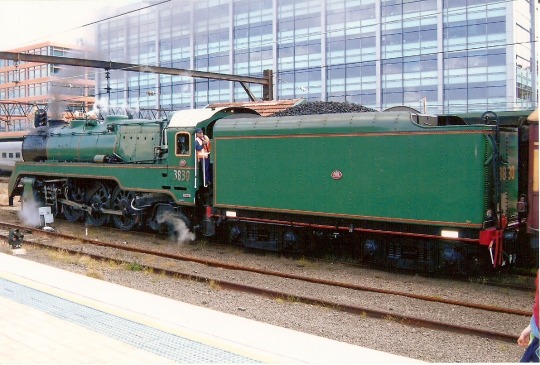
3830 in Sydney
19 notes
·
View notes
Text
Traveling to Sweden by train
Things are slowly calming down again so I decided to spend a one week vacation in the Swedish city of Gothenburg. I want to share this journey with people as I promised friends to take lots of pictures anyway and because it personally means quite a lot to me to finally get out there again. Not only is this finally a proper vacation after a year and a half of sitting at home a lot with the coronavirus pandemic making it unfeasible to travel anywhere farther than where the S-Bahn could carry me. But this is also my first international journey in just over 10 years. Finally I feel comfortable taking on such a trek and because I am apparently a bit silly and like trains I decided to do this journey (nearly) all by train.
Planned route
Now how does one get from Berlin to Gothenburg by train? The route I will be taking starts in Berlin from which I will first board an ICE (InterCity Express; the German high speed train class of DB) to Hamburg to change to an IC (InterCity; a high-ish speed service) which is a joint operation by DB and the Danish national train service taking me all the way to the Danish capital of Copenhagen. From there I can take the Öresundtåg (literally Öresundtrain) over the Öresundbridge across the (can you guess it?) Öresund between Denmark and Sweden. The Öresundtåg stops in the city of Malmö, where I get a high speed train by the Swedish operator SJ that will get me to my destination.
This is quite a trip with a few changes and because I planned this with change times of at least 30 minutes in case there are delays the whole journey will take about 13 hours. The straight distance between the two cities is about 580 kilometres but due to the detour over Jutland the distance actually traveled is closer to 1000 kilometres.
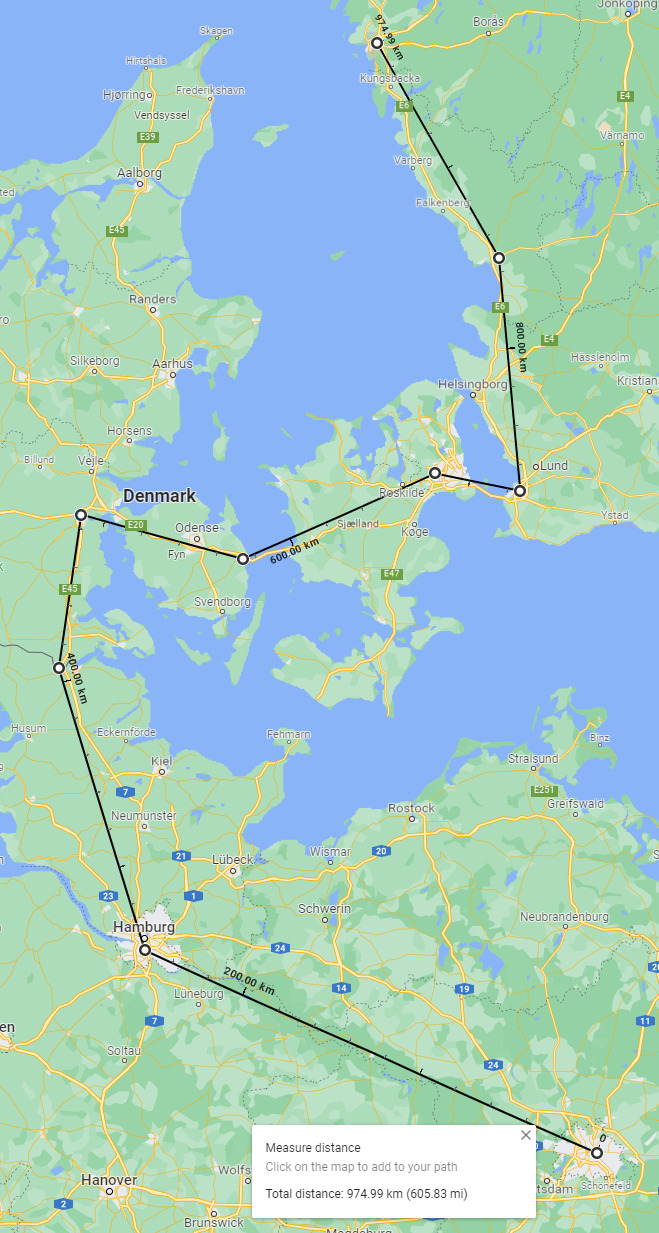
(the route vaguely traced in Google Maps)
I booked the tickets online a few weeks ahead and paid for all second class tickets about 70 € in total (and again about 70 € for the return trip). This was actually quite pleasant. The whole first part of the journey up to Malmö I was able to plan with the website of DB, which cooperates nicely with services of neighboring countries. The booking website of SJ was also easy to use, very user friendly and has a good English translation.
The paperwork
So because this is an international journey we have to consider paperwork of course. You can’t just travel to another country, surely there is a bunch of hoops you have to jump through, right? Well, because of the circumstances, kinda but not really.
First off: no visa required. I am a German citizen and am thus allowed to travel freely within the Schengen-area and the only required document is my ID card. And that is only in case I actually get carded. On train connections that is only done occasionally, but of course I will have my ID with me, so that will not be an issue.
Due to the ongoing Covid-19 pandemic it is also necessary to bring either a negative test result when crossing borders or a certificate of vaccination against the virus. Which I got. You can have it in paper or digitally and two weeks after your second shot you are free to travel again. No quarantining or anything. I got vaccinated anyway, so this was no issue at all.
Over all this got sorted pretty easily and I quickly had everything I need.
As a slight hint for anyone traveling to Sweden for the first time: paying in cash is incredibly uncommon especially in the cities there so I very much advise getting a credit card. I used a simple card I could charge with a bit of money, which I got from my bank with no additional cost and due to the limited money on it, losing it would not have been that bad as well.
Potential obstacles
But of course, stuff happened. Or rather, would maybe happen. I am writing this portion slightly ahead and at the end of reading this you will know, how it actually played out. As will I know, because by then I hopefully will have arrived.
Over the summer of 2021 the train drivers union GDL started talks with DB about raises and compensation over the additional hours drivers had done during the pandemic. Talks broke down though and thus they started striking.
There are more internal factors at play here as well but I am not in the know enough to properly judge or even explain the whole picture. But in the end it also does not really matter because I can’t really change it that quickly. So I have to live with the potential of the trains in Germany being canceled due to strikes. Only in Germany though. As soon as I reach Denmark I will be fine.
The strikes are not full time. They usually go on for two or three days and then normal service resumes within a few hours. And they tend to stick to work days. Which might mean I get lucky as I will depart on a Saturday. But I will watch the news closely and may have to rapidly come up with a backup plan.
Additionally and a bit hilariously I will have to switch onto a rail replacement bus on my journey to Gothenburg. Just on the weekend where I will travel they are doing some bridgework between Malmö and the town of Lund. This is certainly an inconvenience, but I just hope it will work out okay, as it is not that far to Lund. If this was not the case, I would have been able to make this journey exclusively with electric trains.
The strike
And of course it had to happen. On Monday the 30th of August the union announced a strike that would cover a whole week and with that, cover the weekend I wanted to travel on.
But no reason to panic yet. This gave me a few days to figure out how to navigate around this. By Tuesday afternoon DB had figured out which services would still be running.
I got pretty unlucky though. During this strike no DB service would run from Hamburg to Copenhagen. So it became necessary to find another way.
Thankfully I remembered the provider Snälltåget. They run a night train from Berlin all the way to Stockholm with stops in larger cities. Like for example Malmö.
And so for an additional price of just 10€ in total I got my DB ticket refunded, bought a ticket for the Snälltåget service from Saturday 7 in the evening to arrive on Sunday at around 8 in the morning and shifted the ticket I had bought with SJ to a train on Sunday.
Overall that was not nearly as bad as I initially feared and by Tuesday afternoon I had rescheduled.
The journey
Saturday came and in the evening it got time to head out. Due to the strike the S-Bahn service in Berlin was also pretty dodgy so I opted for a route with U-Bahn and bus. Which worked pretty well. The bus was a bit crowded but the whole trip was only a few minutes slower than any S-Bahn connection available to me.
Berlin central station is a very modern steel and glass construction that is very vertical with platforms going east-west above ground and platforms going north-south below ground. Due to the strike there were only few trains around but there were still some passengers taking the few trains in service.
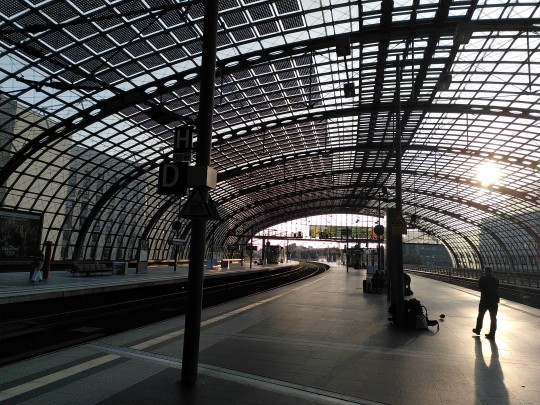
(a view along the upper platforms at Berlin central station with the low sun shining through the glass roof)
About 20 minutes before departure my train pulled onto the platform. Four carriages pulled by an electric loco. Very quickly I had found my seat and was happy to see us depart perfectly on time at 19:02. But then had to stop for twenty minutes just after leaving the city behind, because unauthorized people were on the track.
For this section with Snälltåget I had booked the most basic seat. Fortunately the person who boarded the train in Hamburg at around 22:00 seated next to me found another free seat, so neither of us had to be crammed in our seats and attempt to sleep.
Ah yes, sleep. As this was a night train a reasonable thing to do is to sleep. Unfortunately a few things got in the way of that. Firstly, the cabin light in the open saloon was never turned off. It was comparatively low, but still bright enough to disrupt sleep.
And then came the stop just behind the Danish border. In the small town Padborg, the loco that had hauled us all the way from Berlin got replaced by a Danish locomotive. This is due to a difference in voltage between the countries’ catenary equipment. That alone would have been fine, but unfortunately the Danish border guards deem it necessary to check every single train. And if that means disrupting 200 peoples sleep each night at 2 in the morning then they will do it. Which is what they did.
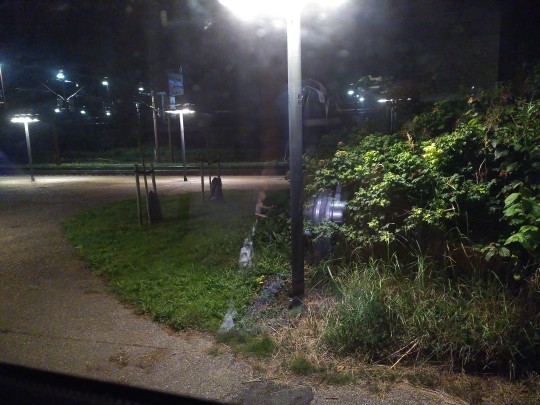
(empty platforms at Padborg, only some bright lamps break the darkness in the dead of night while the border guards board the train)
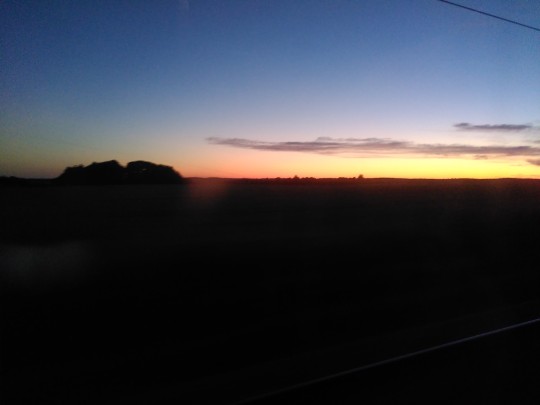
(the sun is just barely rising over the flat and still dark Danish countryside)
During the next few hours I managed to catch a bit of uneasy sleep until the early dawn. Because I realized, that we were nearing Copenhagen I decided to just stay awake and watch the landscape zip by as the sun crept up. And it was worth it.

(banks of mist over fields)
Fields covered in mist like ghostly apparitions. And right as the sun really rose and made it easy to see, we crossed the Öresundbridge. A wonderful view.
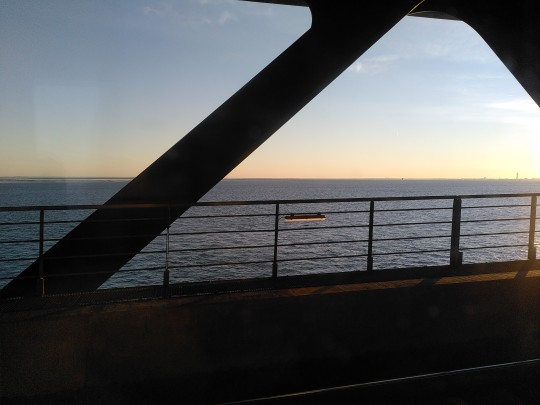
(the metal frame of the Öresundbridge with the sea visible in the background, the sun is shining just out of frame to the right)
After the bridge it was not far to the city of Malmö. Unfortunately we were delayed slightly again. Slowly I felt like fate was trying to keep me from reaching my destination.
But because I was cautious this delay was not enough to mess with my plans. The train arrived slightly delayed at around 08:30.

(the loco that had pulled me through the bit of Sweden I had crossed this far sitting at a platform in Malmö)
I did not take time to look at Malmö central station, but from what I saw it is a nice station with the older platforms being complemented by a modern building housing some shops. But I had a bus to catch, so I headed for one of the exits.
Some helpful staff was able to point me to the replacement bus I now had to take to get to Lund. The bus trip, while a bit inconvenient was actually a nice change. And I got dropped off right in front of the train station an hour before my train was due to depart.
And that last leg of the journey was very pleasant. The X55 even in second class was wonderful to ride. Good leg space, large windows, pleasant decor and a comfortable ride paired with sunny views of the Swedish countryside. This train made it immediately clear to me, that Swedish rail has a wider loading gauge than most other countries and the cars are built accordingly with lots of room. Zooming through hills and past fields at not very high speeds was just a delight.

(a bit of Swedish countryside with fields and farm buildings under a blue sky, in the distance one can just about see the coastline)
And after about 2 and a half hours my final train for that day pulled into Gothenburg central station. Which is a wonderful old station that has been maintained very well. The main concourse still has it’s original dark wood framing and large murals show different old railway lines all under an iron and glass ceiling, which makes it feel large but still cozy. Even tired as I was, I was surprised by how nice this station is.

(the main concourse in Gothenburg central station)
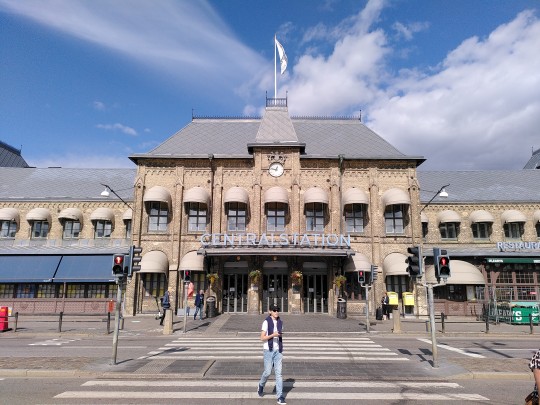
(the front of Gothenburg central station in broad daylight)
From the central station one can easily get anywhere in the city with the many trams or a bus which stop just a hundred meters from the station entrance.
In conclusion
This whole trip is now about two weeks in the past and I had some time to think about it. In general I still think this is a good way to get to Sweden, especially if you are on a budget. Next time I want to try out a proper cabin with a berth on the night train, because I am just too tall to sleep in any way comfortably in a seat.
4 notes
·
View notes
Video
About To Leave For Plymouth (Michael McNicholas) by Neil Harvey 156 Via Flickr: 47658 is about to leave Penzance with 2C83 12:00 Penzance to Plymouth. 21/4/87.
#Railway#47658#Penzance Station#Penzance#Cornwall#Loco Hauled Passenger Train#2C83#Class 47#BR Large Logo#Brush Type 4#Sulzer#Duff#Spoon#Michael McNicholas#trainspam
0 notes
Video
No trains departing por Michael Greenhill Por Flickr: Steamrail's R711 and R761 blast through Hawksburn station in Melbourne's inner east. The two 70-year old steam locos are captured hauling Steamrail's "Snow Train" onwards to Moe - where passengers will transfer to buses for their trip up to the snowfields of Victoria - and then onwards to Traralgon for servicing.
9 notes
·
View notes
Video
British Railways (SR) – ‘N15 Maunsell (King Arthurs) Class’ 4-6-0 No.30784 ‘Sir Nerovens’ (SR 784) on turntable at 70A Nine Elms c1950 by Peter Heelas Via Flickr: The LSWR N15 class was a British 2–cylinder 4-6-0 express passenger steam locomotive designed by Robert W. Urie. The class has a complex build history spanning three sub-classes and eight years of construction from 1918 to 1927. The first batch of the class was constructed for the London and South Western Railway (LSWR), where they hauled heavy express trains to the south coast ports and further west to Exeter. After the Lord Nelsons, they were the second biggest 4-6-0 passenger locomotives on the Southern Railway. They could reach speeds of up to 90 mph (145 km/h). Following the grouping of railway companies in 1923, the LSWR became part of the Southern Railway (SR) and its publicity department gave the N15 locomotives names associated with Arthurian legend; the class hence becoming known as King Arthurs. The Chief Mechanical Engineer (CME) of the newly formed company, Richard Maunsell, modified the Urie locomotives in the light of operational experience and increased the class strength to 74 locomotives. Maunsell and his Chief Draughtsman James Clayton incorporated several improvements, notably to the steam circuit and valve gear. The new locomotives were built over several batches at Eastleigh and Glasgow, leading to the nicknames of "Eastleigh Arthurs", "Scotch Arthurs" and Scotchmen in service.[5] The class was subjected to smoke deflection experiments in 1926, becoming the first British class of steam locomotive to be fitted with smoke deflectors. Maunsell’s successor, Oliver Bulleid, attempted to improve performance by altering exhaust arrangements. The locomotives continued operating with British Railways (BR) until the end of 1962. One example, 30777 Sir Lamiel, is preserved as part of the National Collection and can be seen on mainline railtours. N15 Urie/Maunsell (King Arthurs) Class 4-6-0 No.30784 (784) ‘Sir Nerovens’ was built at North British Loco No.23280 in 1925, in 1948 it was allocated to 71A Eastleigh shed where it remained there until it was withdrawn in 1959. Copyright unknown - taken on 71A Eastleigh Shed c1950
2 notes
·
View notes
Text
An introduction to VR locomotives, part 7/7: the Dr19
So we come to the end of this series of me being horny for locomotives. The last sexy machines to be introduced are so new that they don't even have an established nickname yet, the first locos having only entered service half a year ago: the Dr19.
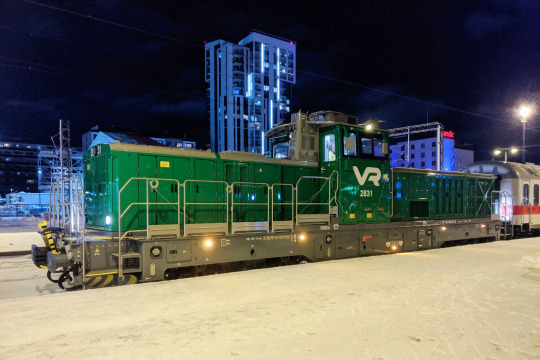
Whereas all our new rolling stock since the early 90s has been based on pre-existing designs, these green beauties were tailored for our need by Stadler Valencia. These robust cuties can withstand temperatures down to -40 degrees Celsius, they are powered by two diesel engines (which can also use biodiesel), and we are already looking into the possibility of turning them into diesel-battery hybrids by replacing one engine with battery packs. As new technology becomes available, the sexy modular design makes it possible to swap out the engines for new, more environmentally friendly versions.
We've ordered 60 of these handsome things, with an option for 100 more. The first Dr19's were delivered in early 2022, and we tested them extensively before putting them to use in commercial service in May this year.
The Dr19 has been optimised for use in freight trains, with a top speed of "only" 120 km/h, but with a power output of 1 900 kW, making them currently our most powerful diesel (but not most powerful of all time, as that title belongs to the sexy French ladies of the Dr13 class, which we retired in 2000). Of course, there's no reason why they can't be used to haul passenger trains too, and they likely will do so for example on the northernmost, non-electrified stretch of the Helsinki-Kolari night train.
The official plan is for the Dr19 to replace our oldest locomotives, the handsome daddies of the Dv12 class. However, as the Dr19 is too heavy to operate on all tracks currently served by the silver daddies, it's likely we'll keep some of them around to keep company to the younger boys and girls. However (and we haven't said this publicly) I would presume the Dr19's will replace the butch ladies of the Dr16 class.
25 notes
·
View notes
Video
Class 37 . by Steven Barker Via Flickr: Large Logo liveried class 37 , 37402 Stephen Middlemore , at Carlisle with a train of 4 Mk2 DRS carriages .
#rs#train#passenger#uk#england#carlisle#west#coast#main#line#37402#stephen#middlemore#diesel#locomotive#loco#hauled#drs#class#37
23 notes
·
View notes
Text
Queensland Rail turned 154 today so here’s some photos!! (part one)

a BB18 1/4 steam engine in action, i think this is the preserved 1079 which i’ve seen in person a good few times

another BB18 1/4 inspecting a family’s garden

one of Queensland’s first passenger services to go up the state (north from Brisbane) was the Sunshine Express, here in Rockhampton in 1955

the Sunshine Express in the 50’s again i’m pretty sure

main line Queensland Rail engines usually haul sugar cane in molasses form etc. after the locos have taken it to their respective mills
i don’t have notes for these two, top one is Queensland’s next passenger service, the Sunlander, which stopped running in 2014 or 2015. it ran from Brisbane, up north to Cairns and back down again over a span of a couple days:


then two coal trains, i’m pretty sure:

and finally:

the entire Sunlander being held up by a car in the (least) perfect spot, outside the Townsville show in the late 70’s
i don’t own these photos!! they’re from the railway history facebook group i’m in
1 note
·
View note


